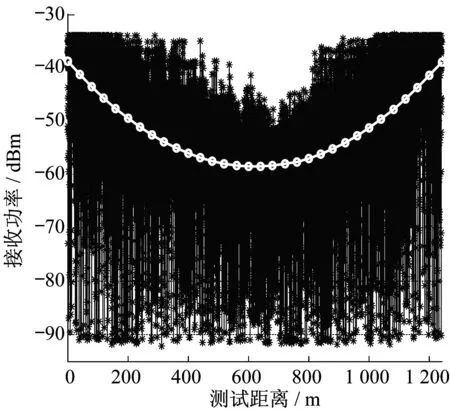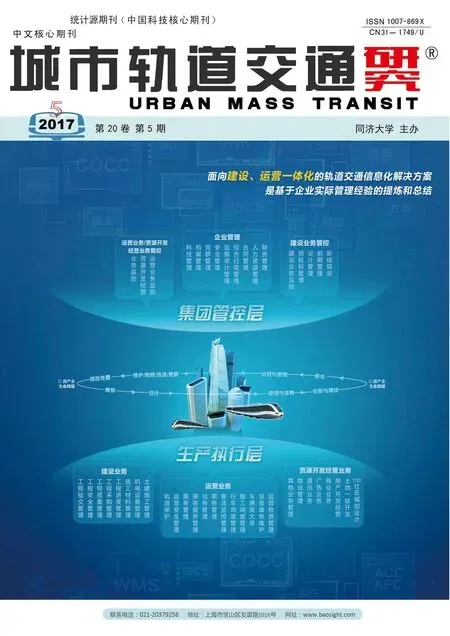城市轨道交通车地通信综合承载系统(LTE-M)性能测试与分析
朱东飞 洪 婷
(武汉地铁集团有限公司,430030,武汉∥第一作者,副总工程师)
城市轨道交通车地通信综合承载系统(LTE-M)性能测试与分析
朱东飞 洪 婷
(武汉地铁集团有限公司,430030,武汉∥第一作者,副总工程师)
在城市轨道交通系统中,各子系统车地通信模块是完全独立的。独立建网造成城市轨道交通沿线缆线密集,结构复杂,对珍贵的频率资源也造成了极大的浪费。目前车地无线普遍采用基于IEEE 802.11的WLAN(无线局域网)技术,该技术存在频点干扰严重、高速性能瓶颈等重要缺陷。为了解决这些问题,将LTE(长期演进)应用到城市轨道交通的车地无线通信系统是很有必要的。设计了基于LTE的城市轨道交通车地通信综合承载系统 (LTE-M),并在武汉地铁进行了LTE-M系统的性能测试。测试结果表明:LTE-M系统具有系统稳定、综合承载能力强的特点,不仅能满足CBTC(基于通信的列车自动控制)系统传输要求,同时还具有为PIS(乘客信息系统)和CCTV(闭路电视监控)系统提供良好通道的能力。
城市轨道交通; 车地通信; 综合承载
Author′s address Wuhan Rail Transit Group Co.,Ltd.,430030,Wuhan,China
0 引言
车地通信是城市轨道交通安全运营的关键。而目前城市轨道交通CBTC(基于通信的列车运行控制)、CCTV(闭路电视监控)和PIS(乘客信息系统)等系统的车地通信,大部分使用的是在公共开放频段工作的局域网技术。目前,实践证明,基于WLAN(无线局域网)的车地通信网络是满足城市轨道交通高速、高密度和高安全性等需求的最佳技术之一[2]。但这种技术不是完美的,也存在一些局限性。比如,WLAN使用的是免费开放频段,不需要无线电委员会的准许。也正因如此,很多民用设备也工作在这一开放频段,如便携式WiFi(Wireless Fidelity)设备、电磁设备等,这些设备都可能干扰车地无线传输。还有就是,WLAN不是为高速移动设计的[2]。2012年深圳地铁2、5号线就曾因上述原因数次出现无线干扰,影响列车运行[3-4]。此外,WLAN不能设置优先级,不能确保给优先级较高的业务更大真实带宽,因此不适合车地通信的综合承载。
LTE(长期演进)是基于OFDMA(正交频分复用多址接入)技术、由3GPP(第三代合作伙伴计划)制定的全球通用技术标准。LTE技术在设计之初,就考虑了满足高吞吐率的需求。在20 MHz带宽组网情况下,上下行峰值速率分别可达100 Mbit/s和50 Mbit/s。并且采用扁平化架构以减少控制平面和用户平面时延。LTE采用了OFDM(正交频分复用)、HARQ(混合反馈重发) 、MIMO(多输入多输出)等先进技术,这些技术能够大幅提升频谱效率、传输速率和抗干扰能力,同时能够支持综合业务承载(满足不同优先级合理分配调度和高移动速度特性),并采用安全机制和抗干扰的办法确保无线数据传输的安全性和可靠性。
TD-LTE是TDD(时分复用)的LTE技术,它是一种专门为移动高宽带应用而设计的无线通信标准,是中国拥有核心自主知识产权的4G(第4代移动通信技术)国际通信标技术标准。本文提出的基于LTE的城市轨道交通车地无线通信综合承载系统(LTE for Metro,LTE-M) 正是利用了TD-LTE技术。
1 城市轨道交通车地生产业务以及服务质量(QoS)需求分析
城市轨道交通中的车地通信承载了CBTC、CCTV、PIS和TOSM(列车运行状态监测)系统等4项基本业务。
CBTC技术主要包括无线电通信技术和自动化控制技术。CBTC车地通信系统的功能是完成车站设备、中心设备、车载设备和轨旁设备之间的信息传输,支持点对点、点对多点之间数据通信,支持对一列车、一组列车或者所有列车有选择地进行通信。CBTC系统要具有控制列车安全行驶的功能,车地通信业务应满足以下要求:① 车地通信覆盖区域应包括正线(折返线、联络线)、段(场)咽喉区、段(场)车库、出入段线、出入场线、试车线;② 采用独立的双网冗余信道;③ 为了保证无线网络的安全性,基站与车载无线单元要进行授权认证,认证通过后才可以关联,并加密传输数据,加密密钥至少为128位;④ 车头和车尾能够与A网、B网双网通信,信号系统无线网络部分与其它部分应隔离。还有,单网传输速率上下行分别至少达到100 kbit/s;单网信息丢包率要低于1%,单网信息误码率小于或等于10;单网跨区切换时间为100 ms以内,信息经有线和无线网络的时延应在150 ms之内;应实现200 km/h行驶速度范围内实时双向通信。
在全自动无人驾驶系统中,CCTV系统起着至关重要的作用。通过车地之间的视频传输,地面控制中心可以实现对驾驶室、设备间、车厢等重点区域的监控,满足列车安全管理的需求,是实现列车安全运行的重要辅助手段。在正常情况下,如果控制中心需要查看车厢视频信息,列车需向控制中心上传不少于2路客室监控画面,每路上行车载CCTV业务带宽需求为1~2 Mbit/s,同时要求监控视频图像清晰、无卡顿。
PIS系统,在正常情况下播放控制中心下发的节目,在异常情况下播放乘客通知和发布运营服务信息。如在车载PIS显示屏上实时显示紧急信息、行车信息、换乘信息、旅行指南、新闻、广告等信息。车地无线综合宽带传输平台要适配PIS的不间断、低时延、高带宽需求。每路图像带宽需求为下行4~6 Mbit/s。紧急文本为上行信息,带宽需求为10 kbit/s。
TOSM系统主要有信息采集、信息传输、信息显示、信息处理分析和信息发布5个工作流程,通过车辆状态信息做到安全投入的效益优化。 TOSM系统需要采集1 500个开关量和500个模拟量。因此要求传输带宽应保证在100 kbit/s,系统车地无线通信的丢包率应低于1%。
总结城市轨道交通车地通信业务的QoS需求如表1所示。
目前,城市轨道交通车地通信业务都采用各自独立的车地通信系统。这种独立的建网方案存在的问题是:设备数量大、故障隐患多;频谱利用率低;投资建设时间长;维护难度大,成本高;系统缺乏可扩展能力。
另一方面,城市轨道交通车地通信系统需要承载综合业务,所承载业务中CBTC系统信息、紧急文本信息、CCTV系统信息等,直接涉及安全问题,对传输的可靠性和实时性都有很高的要求。其中CCTV和PIS还要求满足一定传输带宽。要进行综合承载业务的高可靠、高实时、高带宽传输,接收信号的SINR(信号与干扰加噪声功率比)必须满足一定的要求。除了进行合理的网络规划保证接收信号的功率超过一定的接收门限,还要求接收信号的干扰功率足够小。这就要求要有一个相对干净的无线传输环境保证传输的正常进行。现有的ISM(工业、科学和医疗)频段干扰严重,难以满足综合承载业务传输的要求。因此,有必要设立专用的频段进行城市轨道交通综合业务的传输,以减少无线信号干扰,提高车地通信的可靠性,保证综合业务的传输,满足承载综合业务的要求。
鉴于建立综合承载系统以及设立专用的频段进行综合业务的传输的必要性,提出业界基于LTE的车地通信综合承载系统LTE-M,下文进行具体说明。
2 城市轨道交通车地通信综合承载系统LTE-M
2.1 系统结构设计
目前,LTE-M主要有两种组网方案。
方案一:同频交织组网(见图1)。该方案中,轨旁设备在一个无线接入网下连接成二层网络,二层网络的基站依照站址交织放置,并且采用同样的载波频率来配置。

图1 同频交织组网示意图
相邻的RRU(无线射频单元)与不同的无线基站BBU(射频拉远单元)连接,单个BBU有问题时,相邻RRU增大发射功率从而覆盖故障BBU下RRU覆盖区域。未出现设备问题时,减低发射功率防止相邻基站互相干扰;当有基站问题时,相邻基站增大发射功率覆盖故障基站覆盖区域。这种组网方式的突出特点是频率资源利用率高,因为全网只用一个频段;缺点是增加了不稳定性,因为轨旁设备没有设备备份,若两个相邻基站失效,则系统将无法正常工作。因此本次没有采用这种方案。
方案二:同站址双网覆盖(见图2)。此方案系统为 A、B双网(两张网完全独立,并行且互不干涉)。每张网包括了核心网(EPC)、轨旁无线接入网(eNodeB)、车载无线终端(TAU)。A网络只承载CBTC业务,B网则备份CBTC业务和承载PIS业务。
2.2 专用频段选择
根据我国有关频率资源划分情况,目前可申请的城市轨道交通TD-LTE频段有:1 447~1 467 MHz(固定移动用户频段),1 785~1 805 MHz(行业专网频段),5 850~5 920 MHz (TD-LTE可用频段)。

图2 同站址双网覆盖示意图
因5.9 GHz频段的空间传输损耗过大,且硬件设备仍不成熟,所以1.4 GHz和1.8 GHz更适用于城市轨道交通。已经有城市申请和使用1.8 GHz频段。工信部在最近发布的文件中提出,城市轨道交通可以申请1.8 GHz频段。
为进一步验证LTE技术应用于城市轨道交通综合业务承载的可行性,在武汉地铁开展了现场实地测试。采用实际工程的组网结构,测试LTE-M系统在真实环境中的性能。然后结合目前城市轨道交通车地通信综合承载业务的需求进行分析,最后判断其应用的可行性。
2.3 测试方案和工具
测试搭建的LTE-M系统采用A、B双网冗余的组网方式,一同承载测试业务数据。A网用15 MHz带宽承载CBTC业务、车载CCTV和PIS等业务;B网用5 MHz带宽承载CBTC业务、紧急文本。每个网络都包含EPC、BBU、RRU以及车载无线终端(TAU)。BBU通过以太网交换机直接与两套LTE核心网设备连接,使用光缆连接至轨旁RRU。
测试工具采用业界著名的Ixchariot,服务器端设置在地面,分别在地面和车载布置测试节点。
2.4 测试内容
本次现场实地测试是在真实城市轨道交通环境下,测试LTE-M系统的覆盖能力、系统的车地通信传输性能以及稳定性。测试的内容包括LTE-M的无线覆盖测试、传输性能测试和稳定性测试。
3 测试结果与分析
3.1 LTE-M无线覆盖测试
LTE-M无线覆盖测试,使用1台场强接收仪(罗德斯瓦茨)和1台PC机实现,并将1台GPS(全球定位系统)接收机连接到PC机以获取当前位置。场强接收仪带宽设置为5 MHz,取样间隔设置为:10 ms的情况下,列车从1个RRU运动到相邻RRU时的接收功率变化。由图3可知,在5 MHz带宽下,接收功率的变化范围为-95~-33 dBm(蓝色区域),图中白色曲线表示平均功率在-58~-38 dBm范围内。

图3 5 MHz带宽下接收功率覆盖范围
3.2 LTE-M传输性能测试
传输性能测试项为丢包率、传输时延和吞吐量等。
3.2.1 丢包率测试
测试步骤为:① 按照基本配置完成系统配置;② 记录设备型号、软件版本、RSRP(参考信号接收功率)、SINR、系统带宽、AMC(自适应调制编码)参数、ICIC(小区间干扰协调)是否关闭;③ 测试软件与网络侧进行时间同步;④ UE(用户设备)发起业务;⑤ 使用Ixchariot测试丢包率,包长400 B,丢包率测试应使用100 kbit/s速率发包;⑥ 在试验段多次运行列车,过程中进行丢包测试,结束后,查看测试结果;⑦ 列车以最高限速进行。
测试结果表明:CBTC系统车地通信的上下行丢包率都小于0.01%,满足系统要求。
3.2.2 传输延迟测试
测试步骤为:① 按照基本配置完成系统配置;② 记录设备型号、软件版本、RSRP、SINR、系统带宽、AMC自适应参数、ICIC是否关闭;③ 测试软件与网络侧进行时间同步;④ UE发起业务;⑤ 使用测试软件测试RTT(往返传输时间)时延,包间隔为100 ms大小为400 B。
测试结果表明:CBTC系统车地通信的平均环回时延为32~43 ms,最大环回时延为295 ms。系统传输时延满足CBTC系统小于150 ms的需求。
3.2.3 吞吐量测试
测试步骤为:① 按照网络基本配置完成系统配置;② 记录设备型号、软件版本、RSRP、SINR、系统带宽、AMC自适应参数、ICIC是否关闭;③ UE使用模拟软件发起业务包长1 400 B,饱和流量;④ 采集各层吞吐量;⑤ 列车以最高限速运行,运行6圈;⑥ 双网同时进行测试,A网测试5 M带宽,B网测试15 MHz带宽;⑦ 通过测试软件观察吞吐率是否正常。
测试结果表明:系统频宽为5 MHz时,终端上行平均吞吐率约为5 Mbit/s;系统频宽为15 MHz时,终端上行平均吞吐率为17 Mbit/s。统频宽为5 MHz时,下行平均吞吐率为8~11 Mbit/s;系统频宽为15 MHz时,终端下行平均吞吐率为19 Mbit/s。
由测试结果可知:LTE系统传输吞吐量满足综合承载需求。
3.3 LTE-M系统稳定性测试
LTE-M系统稳定性测试要求:当列车行驶时,系统中同时加载CBTC、PIS、CCTV和列车运行状态监测业务。如表2所示,以能够满足小区和BBU之间发生200次切换的时间长度作为系统运行的最小持续时间,结果显示整个测试过程无通信中断发生。另一方面,通过分别模拟单EPC、单BBU和单RRU等故障情况,测试了冗余网络的功能。测试结果表明:在单网故障情况下冗余网络仍然可以正常工作,列车与控制中心之间的数据链路能够保持连续不中断。

表2 LTE-M系统稳定性测试
4 结语
本文设计了基于LTE的城市轨道交通车地通信综合承载系统(LTE-M),在武汉地铁进行了实地测试。试验结果满足预期,验证了本文设计的LTE-M系统的性能能够满足城市轨道交通业务需求。下一阶段,将继续加速推进LTE-M的技术规范,以规范和指导LTE-M系统的设计、研究工作。
[1] H J T T,ZHAO H L,ZHU L.Design and performance tests in an integrated TD-LTE based train ground communication system[C]∥17thIEEE International Conference onIntelligent Transportation Systems (ITSC) .Qingdao:IEEE,2014:747-750.
[2] ZHU L,YU F R,NING B,et al.Cross-layer handoff design in MIMO enabled WLANs for communication-based train control (CBTC) systems[J].IEEE J.Sel.Areas Commun.,2012,30(4):719-728.
[3] ZHU L,YU F R,NING B,et al.Cross-layer design for video transmissions in metro passenger information systems[J].IEEE Transactionson Vehicular Technology.2011,60(3):1171-1181 .
(上接彩20页)
Commentary
Advanced Informationization Network Architectures are the Foundation of “Smart Metro”
LI Zhonghao
(Deputy Director of Academic Committee of Experts of China Association of Metros)
The modernization construction of China′s urban rail transit began in 1994. After more than 20 years′ efforts, China has become a country with the longest total length of urban rail transit operating lines in the world. The urban rail transit network operation′s forming has become a symbol of first-tier and second-tier cities in China. By the end of “the 13thFive-Year Plan”, the total length of urban rail transit operating lines in Chongqing, Nanjing, Wuhan, Chengdu, Changsha, and Xi′an cities, etc. each will be more than 300 km. The total length of urban rail transit lines in medium- and long-term planning in Beijing, Shanghai, Guangzhou and Shenzhen cities, etc. each will be even more than 1 000 km. This trend will continue for 10~20 years. Especially under the guidance of national policies, such as “Smart Cities” and “Integration of Informationization and Industrialization” (referring to the deeply-combining of informationization and industrialization at the high level), etc., the field of urban rail transit is also pursuing realizing “Smart Metro”, and is pursuing “Intelligent Equipment”. However, the current operation mode of rail transit in most of the cities in China still stays in the single-line operation era. There is still a big gap in the informationization level and the construction speed. Without the foundation of information system and without the advanced network architectures, it is difficult to realize the potential value of large data. “Smart Metro” will only be a castle in the air.
The information systems of urban rail transit are deployed respectively in the external service network, the internal service network and the safety production network. Because of the historical reasons, China′s urban rail transit is constructed in a way that a project′s approving, designing and constructing is separately implemented according to a single line, one line by one line. Therefore, their information systems are mainly deployed on the production networks according to their professional separation. In the 1990s, the signal systems of urban rail transit and AFC systems in China mainly purchased foreign equipment, so we have no ability to realize information systems′ being integrated and optimized. In recent years, with the continuous expansion of the urban rail transit construction scale, the construction speed′s continuous acceleration and the networking operation demand′s increasingly pressing, the seriousness of the urban rail transit informationization network architecture problem has gradually emerged. It has become the urgent task to accelerate the informationization construction of urban rail transit.
The core of the informationization network architectures′ integration of urban rail transit is on the safety production network. Integrating the safety production network inevitably brings about the adjustment of organizational relationship. For example, the wireless transmission between on-board and ground in the CBTC (communication-based train automatic control) system in urban rail transit, under the broadband LTE system, is needed to load comprehensively. This would break the original professional divisions of the signaling system. In the wired networks, it is necessary both to integrate the various professional IT network architectures of this line, and to integrate the network of other lines. The important systems of production and operation of a city′s rail transit will be integrated into one network. The integration of IT network architectures is the upgrading of informationization level, and is even the management revolution, involving the various professions of vehicles, machinery, engineering and electricity. It is a “Top Leadership” project.
Integrating many professional information systems together so as to realize the sharing of information inevitably involves the information security problem. The more information could be shared, the more attention should be paid to information security. For example, in the urban rail transit production system, it must be made clear that CBTC and SCADA (Supervisory Control and Data Acquisition) systems must conform to the 3rd level requirements in the national information security classification protection system. But if each line and each profession respectively realizes the 3rd level requirements of classification protection, then it is very possible to harass the people and waste money, and moreover to cause a lonely information island. It also needs to pay a greater price to realize the information sharing. If all the businesses of a city′s rail transit are integrated into one network, and that belongs respectively to the external service network, the internal service network and the safety production network. As a result, the classification protection requirements of the enterprise networks could be overall realized. Thus, yielding twice the result with half the effort will be achieved.
Some people would ask, “Could the existing networks independent to each other be integrated together under the condition of not affecting the urban rail transit operation if the newly-built urban rail transit lines are constructed according to the new informationization network architectures?” It depends on whether the newly-built networks and their information security guarantee measures are in place and whether they are more secure, reliable, smooth and easier to maintain and manage than the original systems. This would require that the maintenance service system and the management system of information security of the IT network should be established synchronously when the new-type IT networks of urban rail transit are constructed. In this respect, the national railways have much successful experience and that has been proved feasible.
Only if the network architectures of the production system have been integrated, the network architectures of all kinds of lines have been integrated into a production network, the safety production network, the internal service network and the external service network have been integrated into a internal network, and on the basis of such networks, the design and the deployment of information security architectures are implemented, could we stand in the forefront of information technology development, for example, using private clouds, realizing information sharing, and exploring large data applications, etc. Otherwise, each specialty′s implementing 3rd level of hierarchical protection, cloud computing and large data applications, etc. in a very small network scope will only be a kind of technology-following. It is difficult to produce a very good application effectiveness and efficiency, and the intelligent degree of “Smart Metro” will also be greatly reduced.
The next 5 years is 5 years of the unprecedented large-scale constructions of urban rail transit. Many cities each will open more than 200 km operating lines. We must seize this opportunity of a lifetime, with “Smart Metro” as the goal, start from Informationization network architectures, information security and IT services, stand on solid ground, and actively advance, so as not to fail to live up to the historical responsibility the times give us.
(Translated by SUN Zheng)
Test and Analysis of Integrated Service Capacity for Train-ground Communication Based on Metro LTE-M System
ZHU Dongfei,HONG Ting
Since the module of each communication subsystem is completely independent in urban rail transit system, the independent network building causes densely-laid cables along metro rail and complex structure, wasting a large amount of precious frequency resources. At present, the technology of WLAN based on IEEE802.11 is widely used in the field of train-ground wireless, which has some major defects like serious frequency interference, high performance bottleneck and so on. To solve these problems, the use of LTE (long term evolution) in urban rail transit wireless communication system is recommended, an integrated transport service capacity system (LTE-M) for urban rail transit LTE-based LTE is designed, and the performance of the LTE-M system is tested in Wuhan metro. The result shows that the LTE-M system is stable with good integrated service capacity, which can not only satisfy the transmission requirements of CBTC system, but also provide better channels for PIS (passenger information system) and CCTV.
urban rail transit; train-ground communication; integrated service capacity
U 231.7
10.16037/j.1007-869x.2017.05.037
2017-01-05)

